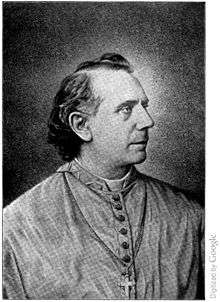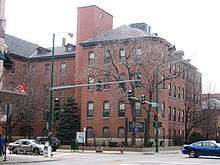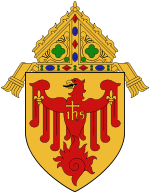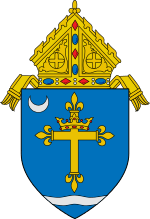Patrick Feehan
Patrick Augustine Feehan (August 28, 1829 – July 12, 1902), was an Irish-born American Catholic bishop. He served as the fifth Bishop and first Archbishop of Chicago between 1880 and 1902, during which the church in Chicago was elevated to an archdiocese.
His Excellency, The Most Reverend Patrick A. Feehan | |
|---|---|
| Archbishop of Chicago | |
 | |
| Church | Roman Catholic Church |
| See | Chicago |
| In office | September 10, 1880 – July 12, 1902 |
| Predecessor | James Duggan |
| Successor | James Edward Quigley |
| Orders | |
| Ordination | November 1, 1852 |
| Consecration | November 12, 1865 |
| Personal details | |
| Born | August 28, 1829 Killenaulee, Ireland |
| Died | July 12, 1902 (aged 72) Chicago, Illinois |
| Previous post | Bishop of Nashville |
Biography
Patrick Augustine Feehan was born in Killenaulee, County Tipperary, in Ireland, to Patrick and Judith Cooney Feehan. His father was a gentleman farmer. At the age of ten he was sent to live with his paternal grandfather in order to attend school in Fethard. He returned to Killenaullee two years later when a school opened there, and at the age of fourteen took up the study of Gaelic. In 1845 he entered Castleknock College as an ecclesiastic student, where he befriended Charles Russell. In January 1847 he entered Maynooth College where he spent five years.[1]
Archbishop Peter Richard Kenrick of St. Louis, Missouri had opened a seminary in Carondelet. Himself a graduate of Maynooth, Kenrick made a request of the faculty that Feehan, who was scheduled to become a professor, be transferred to the archdiocese of St. Louis. In 1852 Feehan left for the United States; his family had emigrated there two years earlier.[1]
Pastor
Feehan was ordained on November 1, 1852 and assigned to teach at the diocesan seminary. In July 1853 he was assigned to St. John's parish in St. Louis, where during a cholera epidemic he tended the sick and coffined the dead. The following year he became President of the Theological Seminary in Carondelet. In 1858 he was appointed pastor of St. Michael's in St. Louis, and a year later pastor of the Church of the Immaculate Conception where he established the Society of Saint Vincent de Paul to aid the poor. During the Civil War, the Sisters of Charity were given charge of a hospital located in the parish, where Feehan spent long hours comforting the sick and wounded. After the Battle of Shiloh in April 1862, boatloads of wounded soldiers were brought to the city. For three days in succession, Feehan moved along the wharf and the stretchers laid in rows on the street administering last rites to those who would not make it to hospital.[1]
Bishop of Nashville
Feehan was appointed Bishop of the Diocese of Nashville on June 7, 1865 and consecrated bishop on November 12, 1865. During the summer and fall of 1866 he worked to relieve the suffering of those suffering from an outbreak of cholera.[2] In October 1866 he took part in the Second Plenary Council of Baltimore.
The diocese of Nashville, Tennessee, was also hard hit by bank closures and the depression of 1873. Bishop Feehan encouraged a group of men to create a fraternal organization that would be known as Catholic Knights of America. It was chartered in the nearby state of Kentucky in 1877. The Catholic Knights of America celebrated its 125th Anniversary in 2002. In 2005 Catholic Knights of America merged with Catholic Knights Insurance Society of Milwaukee. In 2010 the organization merged with Catholic Family Life Insurance to form Catholic Financial Life, the second largest fraternal benefit organization in the United States.[3]
In 1877 and 1878 the Diocese was swept by yellow fever and lost thirteen religious sisters and nine priests, including the vicar-general.[4]
Archbishop of Chicago
On September 10, 1880, he was appointed Chicago's first archbishop. From 1880 to 1902, the Catholic population of Chicago nearly quadrupled, to 800,000, largely due to the arrival of immigrants. In adding to the Irish and German communities already established, Polish, Bohemian, French, Lithuanian, Italian, Croatian, Slovak and Dutch Catholics brought their own unique cultural traditions.
Chicago was still feeling the effects of the Great Fire of 1871, which destroyed many of the schools and churches. Feehan accommodated these diverse needs by creating parishes to serve ethnic communities and recruited religious orders from their home countries to staff them. Of the 140 parishes he founded, 52 percent served a particular ethnic community. According to Rev. Martin Zielinski, an associate professor of Catholic history at Mundelein Seminary, the parishes provided a place where immigrants could find familiar fraternal organizations, music, and language. They served as a haven from xenophobia and hostility directed toward immigrants and Catholics.[5]

Feehan was a strong supporter of Catholic education, and promoted it at the exhibition at the 1893 World's Columbian Exposition.[6] "Archbishop Feehan believed a strong system of Catholic education would solve the problem of inconsistent religious instruction at home, and unify a rapidly diversifying Catholic America."[7] He also brought the Vincentians to Chicago to start what is now DePaul University.
Epidemics of cholera and yellow fever left scores of orphans to fend for themselves. In 1881 Feehan established the St. Vincent Orphan Asylum, and in 1883 St. Mary's Training School for Boys, a trade school for homeless boys, now known as Maryville Academy. This was followed in 1887 with St. Paul's Home for Working Boys, now known as Mercy Home.[5]
Feehan preferred to keep a low profile; relatively few speeches and sermons exist from his 22-year tenure.[5] When he died in 1902, the Chicago Tribune praised his "diplomatic handling" of the various ethnic groups in the diocese.[8]
Notes
- Kirkfleet, Cornelius James OP, The Life of Patrick Augustine Feehan, Open Library, Matre & Company Ltd., Chicago, 1922
- "Archbishop Patrick Augustine Feehan", A Biographical History: With Portraits, of Prominent Men of the Great West, Manhattan publishing Company, Chicago, Ill., 1894
- "Our History", Catholic Financial Life
- "Former Bishops", Diocese of Nashville
- Brachear, Manya A., "Chicago's first archbishop was 'good prelate, good man'", Chicago Tribune, May 19, 2013
- "From Feehan to Cupich: meet Chicago's Catholic leaders", Chicago Tribune, September 23, 2014
- Mercado, Monica. "Archbishop Patrick A. Feehan and Catholic Chicago", Faith in the City
- Holli, Melvin and Jones, Peter d'Alroy. Ethnic Chicago, Wm. B. Eerdmans Publishing, 1995 ISBN 9780802870537
| Catholic Church titles | ||
|---|---|---|
| Preceded by Bishop James Duggan |
Archbishop of Chicago 1880–1902 |
Succeeded by Archbishop James Edward Quigley |
| Preceded by James Whelan |
Bishop of Nashville 1865–1880 |
Succeeded by Joseph Rademacher |


